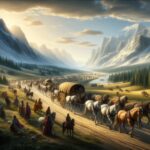Urban development and the disappearance of horse utility reflect a significant transformation in the relationship between humans and their environment. As cities expand and modernize, the role of horses in daily life has diminished, leading to profound changes in transportation, labor, and the very fabric of urban society. This article explores how urbanization has contributed to the decline of horse utility and the implications of this shift.
The Decline of Horse Utility in Urban Settings
The decline of horse utility in urban settings is a multifaceted phenomenon that can be attributed to various interconnected factors. As cities grew larger and more complex, the demands of urban life began to outpace the capabilities of horses as a primary means of transportation and labor.
Industrialization and Mechanization
Industrialization played a pivotal role in the decline of horse utility. The advent of mechanized transportation, such as steam engines and later gasoline-powered vehicles, revolutionized the way goods and people moved within urban areas. Consequently, horses, once indispensable for hauling goods, became increasingly redundant. The efficiency and speed of motor vehicles rendered horse-drawn carts obsolete, leading to a dramatic reduction in their numbers on city streets.
Changing Urban Landscapes
Additionally, changing urban landscapes contributed to the decline of horse utility. As cities expanded, the infrastructure required to support a growing population necessitated the development of paved roads and highways, which were better suited for motor vehicles than horses. Furthermore, the rise of suburban living and the automobile culture shifted the focus away from traditional forms of transport, leading to a further decrease in the reliance on horses.
The Cultural Shift Away from Equine Companionship
The cultural shift away from equine companionship has also been noteworthy, as societies increasingly embraced technology and urban living. This transition has not only affected transportation but has also altered the social dynamics surrounding horses.
Horses in Popular Culture
Once revered as symbols of strength, nobility, and companionship, horses have seen their status change in popular culture. The romanticized image of the horse as a companion or a crucial part of rural life has largely given way to a more utilitarian view of animals. As urban dwellers become distanced from agricultural practices, the connection to horses diminishes, leading to a societal perception that often overlooks their historical significance.
The Rise of Equestrian Sports and Leisure Activities
Although the utility of horses has declined in everyday urban contexts, there has been a notable rise in equestrian sports and leisure activities. This shift reflects a new way of engaging with horses, one that emphasizes recreation rather than utility. Riding schools, horse shows, and competitive events have flourished, catering to a society that seeks to reconnect with these magnificent creatures, albeit in a more leisurely context.
The Future of Urban Development and Horse Utility
The future of urban development and horse utility remains uncertain, as cities grapple with the legacies of their past while looking to innovate for the future. The growing interest in sustainable living and alternative modes of transportation may provide new avenues for integrating horse utility into urban spaces once more.
Sustainable Urban Planning
Sustainable urban planning initiatives are increasingly recognizing the potential benefits of incorporating equine elements into urban environments. This includes developing riding paths, integrating stables into community designs, and fostering a culture that values diverse transportation methods. Such approaches may not only enhance urban aesthetics but also promote a harmonious coexistence between city dwellers and horses.
A Reconsideration of Historical Roles
As society evolves, there may be a reconsideration of the historical roles horses played in urban settings. Educational programs aimed at raising awareness about the contributions of horses to urban development can help restore appreciation for these animals. Moreover, as cities confront challenges related to traffic congestion and environmental sustainability, horses may find a renewed niche as eco-friendly transportation alternatives in specific contexts.
In conclusion, urban development and the disappearance of horse utility illustrate a complex interplay of technological advancement, cultural shifts, and changing urban landscapes. While the role of horses in city life has diminished significantly, there remains potential for a future where their contributions are recognized and valued anew. As urban areas continue to evolve, the story of horses in these environments is far from over.


